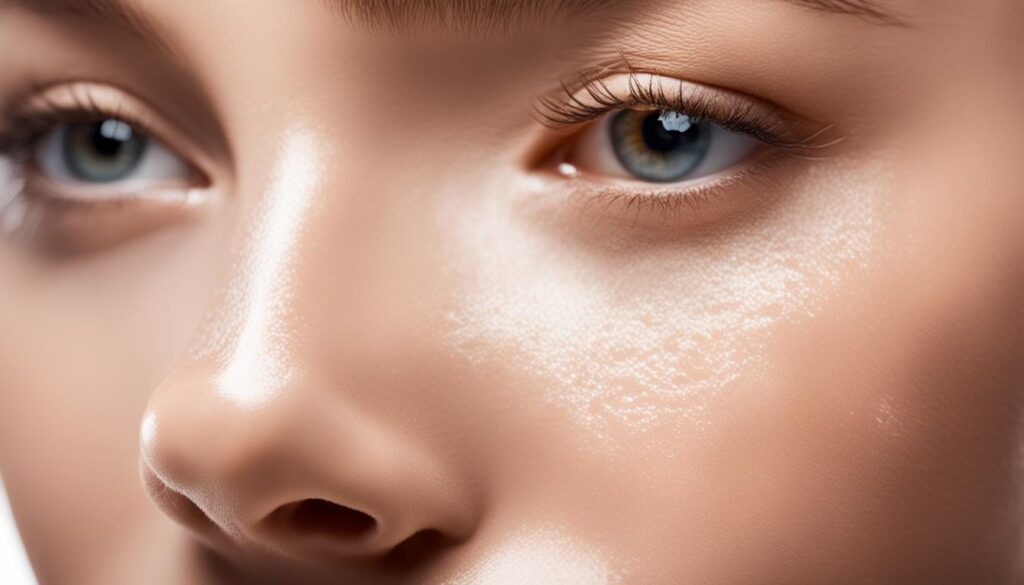As a passionate advocate for healthy and radiant skin, I have discovered the numerous benefits of alpha hydroxy acids (AHAs) in skincare. These chemical exfoliants have the power to transform your complexion and leave you with a vibrant and youthful glow. In this article, I will share my insight into the benefits of AHAs, how they work, and how you can incorporate them into your skincare routine for optimum results.
Key Takeaways:
- Alpha hydroxy acids (AHAs) are chemical exfoliants that remove dead skin cells and improve the overall texture and appearance of the skin.
- AHAs can increase collagen production, reduce the appearance of fine lines and wrinkles, and promote a more even skin tone.
- Glycolic acid, lactic acid, mandelic acid, tartaric acid, malic acid, and citric acid are common types of AHAs used in skincare products.
- It is important to start slowly with AHAs, choose products suitable for your skin type, and protect your skin from sun exposure.
- Natural sources of AHAs, such as fruits and dairy products, can be used as alternatives to synthetic products.
Different Types of AHAs and Their Benefits for the Skin
When it comes to skincare, alpha hydroxy acids (AHAs) are a popular choice for their exfoliating and rejuvenating properties. AHAs help to slough off dead skin cells and stimulate cell turnover, revealing a brighter and smoother complexion. There are different types of AHAs, each with its unique benefits for the skin.
1. Glycolic Acid:
Glycolic acid is derived from sugar cane and is known for its small molecular size, allowing it to penetrate deeply into the skin. It effectively exfoliates the skin, improves skin texture, and reduces the appearance of fine lines and wrinkles.
2. Lactic Acid:
Derived from milk, lactic acid is a gentle AHA that provides hydration to the skin while helping to reduce the appearance of dark spots and hyperpigmentation. It is suitable for all skin types, including sensitive skin.
3. Mandelic Acid:
Derived from bitter almonds, mandelic acid has a larger molecular size compared to other AHAs, making it ideal for sensitive skin. It exfoliates gently, improves skin texture, and helps to reduce the appearance of acne and blemishes.
4. Tartaric Acid:
Tartaric acid is derived from grapes and offers moderate exfoliation. It helps to improve skin texture and promote a smoother complexion.
5. Malic Acid:
Derived from apples and pears, malic acid provides hydration to the skin and improves overall skin texture. It is known for its brightening properties and can help even out skin tone.
6. Citric Acid:
Citric acid is derived from citrus fruits and offers exfoliating and brightening properties. It helps to promote a more radiant and glowing complexion.
Each type of AHA has its own unique benefits and can cater to various skin concerns and types. Incorporating products with different types of AHAs into your skincare routine can help you achieve healthier and more youthful-looking skin.
| Type of AHA | Natural Source |
|---|---|
| Glycolic Acid | Sugar cane |
| Lactic Acid | Milk |
| Mandelic Acid | Bitter almonds |
| Tartaric Acid | Grapes |
| Malic Acid | Apples and pears |
| Citric Acid | Citrus fruits |
By choosing skincare products or incorporating natural sources of AHAs into your routine, you can enjoy the myriad benefits these acids have to offer. Whether you opt for glycolic acid’s potent exfoliation, lactic acid’s gentle hydration, or the brightening properties of citrus-derived citric acid, AHAs can be a game-changer in your skincare journey.
The Power of Exfoliation for Healthy Skin
AHAs, or Alpha Hydroxy Acids, offer multiple benefits for the skin. Incorporating AHAs into your skincare routine can help you achieve a healthier and more radiant complexion. Let’s explore the importance of AHA in skincare and the many benefits it brings to your skin.
Promoting a More Even Skin Tone
AHAs work wonders in promoting a more even skin tone. These chemical exfoliants help to break down the buildup of dead skin cells on the surface, revealing fresh and brighter skin underneath.
By gently removing the top layer of dead skin cells, AHAs can minimize the appearance of hyperpigmentation, age spots, and sun damage, resulting in a more even and balanced complexion.
Improving Skin Texture and Reducing Fine Lines
AHA exfoliation benefits extend beyond evening out the skin tone. Regular use of AHAs can help improve skin texture, making it smoother and more refined. These exfoliants work by stimulating the production of collagen, a protein that keeps the skin firm and plump.
With increased collagen production, fine lines and wrinkles become less noticeable. The skin appears more youthful and vibrant, with a noticeable improvement in texture and elasticity.
Unclogging Pores and Preventing Breakouts
AHAs are particularly effective at unclogging pores and preventing breakouts. By exfoliating the skin, these acids help remove impurities, excess oil, and dead skin cells that can clog the pores and lead to acne and blackheads.
Regular use of AHAs can also help reduce the appearance of existing blemishes and prevent new ones from forming, resulting in clearer and healthier-looking skin.
Enhancing Product Penetration
Another significant advantage of using AHAs is their ability to enhance the penetration of other skincare products. By exfoliating the top layer of the skin, AHAs allow serums, moisturizers, and other treatments to penetrate more deeply and effectively.
This increased penetration ensures that the active ingredients in your skincare routine can work at their full potential, delivering optimal results for your skin.
The Power of Exfoliation for Firmer and More Youthful Skin
As mentioned earlier, AHAs stimulate collagen production, which contributes to firmer and more youthful-looking skin. Collagen is essential for maintaining the skin’s structure and elasticity, and the increased production resulting from AHA use can lead to a visible improvement in skin firmness.
By incorporating AHAs into your skincare routine, you can support your skin’s natural collagen production, helping to keep your skin looking youthful and healthy.

Tips for Using Alpha Hydroxy Acids Safely and Effectively
When incorporating AHAs into your skincare routine, it is important to start slowly and build up a tolerance to avoid potential irritation. Choose skincare products that contain AHAs in appropriate concentrations for your skin type. It is also crucial to wear sunscreen during the day as AHAs can increase sensitivity to the sun.
Start by using AHA products once or twice a week, and gradually increase the frequency as your skin becomes accustomed to the exfoliation. Look for skincare products with AHAs, such as cleansers, serums, toners, and moisturizers, that suit your specific skincare needs and preferences.
- Start slowly and build up tolerance
- Choose appropriate concentrations for your skin type
- Wear sunscreen during the day
- Start with once or twice a week, then increase frequency
- Look for skincare products with AHAs
Product Recommendations
| Product | Description | Key Ingredients | Price |
|---|---|---|---|
| Cosrx AHA 7 Whitehead Power Liquid | A gentle exfoliating toner that helps to remove dead skin cells and reduce the appearance of whiteheads. Suitable for all skin types. | Glycolic Acid (7%), Apple Fruit Water | $18 |
| Paula’s Choice Skin Perfecting 8% AHA Gel Exfoliant | A lightweight gel exfoliant that improves skin texture, reduces the appearance of pores, and evens out skin tone. Suitable for normal to dry skin. | Glycolic Acid (8%) | $29 |
| The Ordinary Lactic Acid 10% + HA | A mild lactic acid serum that exfoliates the skin, improves hydration, and reduces the appearance of fine lines and wrinkles. Suitable for all skin types. | Lactic Acid (10%), Hyaluronic Acid | $6.50 |
Remember to always patch test new products and consult a dermatologist if you experience any severe irritation.
By following these tips and incorporating AHAs into your skincare routine, you can safely and effectively enjoy the benefits of these powerful exfoliating ingredients.
Understanding the Safety Profile of AHAs
When it comes to skincare, safety is a top priority. Understanding the safety profile of alpha hydroxy acids (AHAs) is crucial in order to use them effectively and avoid potential side effects. AHAs are generally considered safe for use in skincare when used correctly and in appropriate concentrations. However, it’s important to be aware of the potential side effects that AHAs may cause, especially when first incorporating them into your skincare routine.
Common side effects of AHAs include:
- Redness: AHAs can cause temporary redness, similar to a mild sunburn. This is a normal reaction and should subside within a few hours.
- Dryness: AHAs can temporarily dry out the skin due to their exfoliating properties. It’s important to follow up with a moisturizer to keep the skin hydrated.
- Sensitivity: AHAs can make the skin more sensitive to other skincare products, sun exposure, and environmental factors. It’s crucial to use sunscreen daily and avoid excessive sun exposure.
To use AHAs safely and effectively, here are some tips:
- Start Slowly: Begin by using AHA products once or twice a week, and gradually increase the frequency as your skin becomes accustomed to the exfoliation.
- Follow Instructions: Always read and follow the instructions provided with skincare products containing AHAs. These instructions will guide you on how often to use the product and the amount to apply.
- Avoid Overuse: It’s important not to overuse AHAs, as this can lead to excessive exfoliation and potential skin irritation. Stick to the recommended usage guidelines.
- Perform a Patch Test: If you have sensitive skin or are concerned about a potential reaction, perform a patch test by applying a small amount of the product to a small area of your skin. Monitor the area for any adverse reactions before applying it to the entire face.
- Consult a Dermatologist: If you experience severe irritation, discomfort, or any other concerning symptoms, discontinue the use of AHAs and consult a dermatologist for further guidance.
Note: Individuals with sensitive skin or certain skin conditions, such as eczema or rosacea, may be more prone to adverse reactions when using AHAs. It’s important to consult with a dermatologist before incorporating AHAs into your skincare routine if you have any underlying skin concerns.
Remember, understanding the safety profile of AHAs is key to enjoying their numerous benefits while minimizing the risk of side effects. By using AHAs correctly and following the recommended guidelines, you can safely incorporate these powerful exfoliants into your skincare regimen and achieve healthy, glowing skin.
Potential Side Effects of AHAs
| Side Effects | Description |
|---|---|
| Redness | Temporary redness, similar to a mild sunburn. Usually subsides within a few hours. |
| Dryness | Temporary drying of the skin due to the exfoliating properties of AHAs. It’s important to moisturize the skin adequately. |
| Sensitivity | Increased sensitivity to other skincare products, sun exposure, and environmental factors. Sunscreen should be used daily. |

Top Skincare Products with Alpha Hydroxy Acids
When it comes to skincare products with Alpha Hydroxy Acids (AHAs), there are numerous options available in the market. These products are formulated to harness the power of AHAs to provide various skincare benefits. From cleansers and toners to serums, creams, and masks, you can find the perfect AHA-infused product for your skincare routine.
Choosing the best skincare product with AHA involves considering reputable brands that prioritize quality and safety. Look for products that specifically cater to your skincare concerns, whether it’s exfoliation, anti-aging, or brightening. Keep in mind that different products may contain varying concentrations of AHAs, so it’s important to choose the right one for your skin type.
Additionally, it’s beneficial to select skincare products that combine AHAs with other beneficial ingredients. This synergy can enhance the overall effectiveness of the product and provide comprehensive skincare results. For example, products that incorporate AHAs with hyaluronic acid can provide hydration alongside exfoliation, promoting plumper and smoother skin.
To give you an idea of the range of skincare products available, here’s a list of some popular options:
- Glycolic acid cleansers: These cleansers effectively remove dirt and impurities while exfoliating the skin.
- Lactic acid toners: Lactic acid toners help to balance the skin’s pH levels and provide gentle exfoliation.
- Mandelic acid serums: Ideal for sensitive skin, mandelic acid serums offer exfoliation and brightening properties without causing irritation.
- Tartaric acid creams: Creams enriched with tartaric acid can improve skin texture and promote a smoother complexion.
- Malic acid masks: Malic acid masks provide hydration and revitalization to the skin, leaving it refreshed and glowing.
Remember to always follow the instructions provided with the skincare products and introduce AHAs into your routine gradually to avoid any potential irritation. With the right skincare products infused with Alpha Hydroxy Acids, you can enhance your skincare routine and achieve healthier, more radiant skin.
The Science of AHAs and Their Effects on the Skin
AHAs, or alpha hydroxy acids, work by breaking down the intercellular glue that holds dead skin cells together. This process allows the dead cells to be exfoliated away, promoting the growth of new skin cells and increasing the skin’s shedding process. The effects of AHAs on the skin go beyond exfoliation.
AHAs also stimulate collagen production, a protein that helps improve skin elasticity and reduce the appearance of fine lines and wrinkles. By increasing collagen production, AHAs can help in achieving firmer and more youthful-looking skin. Additionally, AHAs have the ability to enhance the absorption of other skincare ingredients, making them more effective.
The effects of AHAs on the skin have been thoroughly studied and supported by scientific research and clinical studies. The science behind AHAs confirms their ability to improve overall skin texture and tone, resulting in a more youthful and healthy appearance.

Scientifically Proven Effects of AHAs on the Skin:
- Promotes exfoliation of dead skin cells
- Increases the skin’s shedding process
- Stimulates collagen production
- Improves skin elasticity
- Reduces the appearance of fine lines and wrinkles
- Enhances absorption of other skincare ingredients
- Improves overall skin texture and tone
These scientifically proven effects of AHAs on the skin make them a valuable ingredient in skincare products. Incorporating AHAs into your skincare routine can help you achieve a more radiant and youthful complexion.
Harnessing the Power of Natural AHAs for Skincare
When it comes to skincare, natural ingredients have always been a popular choice. They offer a gentle yet effective way to nourish and improve the skin, and natural sources of alpha hydroxy acids (AHAs) are no exception.
Many fruits and dairy products contain AHAs, making them excellent natural alternatives to synthetic skincare products. Some examples of natural sources of AHAs include:
- Citrus fruits like oranges, lemons, and grapefruits
- Apples and pears
- Grapes
- Milk and other dairy products
These natural AHAs can be incorporated into your skincare routine in different ways. You can create homemade skincare remedies using fresh fruits or dairy products, or you can find commercially available products that contain natural AHAs.
Benefits of Natural AHAs
Natural AHAs offer a range of benefits for the skin. They gently exfoliate the skin, helping to remove dead skin cells and promote cell turnover. This can result in a smoother, brighter complexion. Natural AHAs also have hydrating properties, which can help to improve skin texture and reduce dryness.
“Using natural sources of AHAs in skincare is a great way to nourish the skin and promote a healthy, radiant appearance.”
They can also help to reduce the appearance of dark spots and hyperpigmentation, making them a suitable choice for those concerned with uneven skin tone. In addition, natural AHAs have antioxidant properties that can help protect the skin from environmental damage.
Caution with DIY Skincare Preparations
While natural AHAs can be beneficial for the skin, it’s important to exercise caution when using them in DIY skincare preparations. The concentration of AHAs in natural sources may vary, which means the effects on the skin may also differ.
It’s recommended to start with small amounts of natural AHAs and gradually increase their concentration over time.
If you’re unsure about using natural AHAs in DIY skincare, there are plenty of commercially available products that harness the power of natural AHAs. These products are formulated with specific concentrations of AHAs to ensure safety and efficacy.
Remember, whether you choose to incorporate natural AHAs into your skincare routine through DIY preparations or commercially available products, it’s always wise to perform a patch test before applying them to your face.
I recommend consulting with a skincare professional or dermatologist to determine the best course of action for your specific skin concerns.
By harnessing the power of natural AHAs, you can enhance your skincare routine with gentle yet effective ingredients that promote a healthy, radiant complexion.
The Final Verdict on Alpha Hydroxy Acids
When it comes to achieving healthy and radiant skin, Alpha Hydroxy Acids (AHAs) are a game-changer. These powerful exfoliants offer numerous benefits, from removing dead skin cells to stimulating collagen production. By incorporating AHAs into your skincare routine, you can improve skin texture, reduce the appearance of fine lines and wrinkles, and achieve a more youthful complexion.
Using AHAs safely and effectively is key to reaping their many rewards. It’s important to start slowly and allow your skin to build up a tolerance to AHAs. Begin with a low concentration and gradually increase as your skin adjusts. Remember to protect your skin from sun exposure by wearing sunscreen, as AHAs can increase sensitivity to the sun.
Choosing the right skincare products that contain AHAs is crucial. Look for trusted brands that offer appropriate concentrations of AHAs for your skin type. Whether it’s cleansers, toners, serums, or creams, there are a variety of options available to suit your specific skincare needs. By understanding the science behind AHAs and their effects on the skin, you can make informed choices and achieve the best results.
Furthermore, if you prefer natural alternatives, consider incorporating AHAs from fruits like citrus, apples, grapes, and pears into your skincare routine. These natural sources offer similar benefits to synthetic AHAs and can be used in homemade remedies or commercially available products. Just remember to be cautious with the concentration when using natural AHAs in DIY preparations.
FAQ
What are alpha hydroxy acids (AHAs) and how do they benefit the skin?
Alpha hydroxy acids (AHAs) are chemical exfoliants that help remove dead skin cells and promote a healthier complexion. They can increase collagen production, reduce fine lines and wrinkles, improve skin texture, and promote an even skin tone.
What are the different types of alpha hydroxy acids and their benefits for the skin?
The most commonly used AHAs in skincare products are glycolic acid, lactic acid, mandelic acid, tartaric acid, malic acid, and citric acid. Each type of AHA offers unique benefits, such as glycolic acid’s ability to exfoliate and improve skin texture, lactic acid’s hydrating properties, and mandelic acid’s suitability for sensitive skin.
How do alpha hydroxy acids exfoliate the skin and why is exfoliation important?
AHAs work by breaking down the “glue” that holds dead skin cells together, allowing them to be easily exfoliated away. Exfoliation is important because it promotes the shedding of dead skin cells, stimulates collagen production, and improves overall skin texture and tone.
How can alpha hydroxy acids be used safely and effectively in skincare routines?
To use AHAs safely and effectively, start slowly and build up tolerance, choose products with appropriate concentrations for your skin type, and always wear sunscreen. Incorporate AHA products gradually and adjust frequency as your skin becomes accustomed to exfoliation.
Are there any potential side effects of using alpha hydroxy acids?
While AHAs are generally safe for use, they can cause mild side effects such as redness, dryness, and sensitivity. It’s important to follow product instructions, avoid overuse, and discontinue use if severe irritation occurs. Perform a patch test before applying AHAs to the entire face.
What are some of the best skincare products containing alpha hydroxy acids?
There are various skincare products available that contain AHAs, including cleansers, toners, serums, creams, and masks. It’s recommended to choose products from reputable brands that suit your specific skincare concerns and preferences. Look for appropriate concentrations of AHAs for your skin type.
What is the science behind alpha hydroxy acids and their effects on the skin?
AHAs work by breaking down intercellular glue to exfoliate and promote the growth of new skin cells. They also stimulate collagen production, enhance absorption of other skincare ingredients, and improve overall skin texture and tone. Scientific research and clinical studies support their effectiveness.
Can natural sources of alpha hydroxy acids be used in skincare?
Yes, many natural ingredients contain AHAs and can be used as alternatives to synthetic products. Fruits like citrus, apples, grapes, and pears, as well as dairy products like milk, are examples of natural sources of AHAs. Caution should be exercised when using natural sources, as their AHA concentration may vary.
Are alpha hydroxy acids healthy for the skin?
Yes, alpha hydroxy acids offer numerous benefits for the skin, including exfoliation, collagen production, improved texture, and reduced fine lines and wrinkles. When used correctly, they can be safely incorporated into a skincare routine, leading to healthier and more radiant skin.






